North American Center for Emergency Communications This page provides excellent views of the construction and installation details for a rhombic antenna station constructed in Minnesota to provide health and welfare communications for the US forces involved in Saudi Arabia and elsewhere in the Persian Gulf. The antennas were a twin pair of rhombics that were roughly 450 x 275 ft, mounted on 105 ft cedar power poles, terminated with TMC terminators and fed with 7/8 in hard line into TMC broad band high power Rhombic Balluns. The antennas were also co-phasable. The table below will allow the reader to browse various images related to stepping the 104 foot cedar poles and the construction of termination, feedlines and the antenna curtain. There are several views of the unmistakeable sight of rhombic poles popping up to 100 feet as seen from a distance. They give a good impression of what the old W6AM station looked like (although his poles were unique in that he put two retired poles butt to butt with angle iron to join them, his also were spiked into the ground rather than set with 10 percent of the pole in the ground <>). Many thanks to Mr.. Edward Addy (KE0EG), Founder & Director The Desert Voices Project, (DVP) The North American Center For Emergency Communications, (NACEC)
 | | Here are the four 105 ft cedar poles used on rhombic #1, the east most rhombic. |
 | | Here the construction crew is installing the mounting hardware onto one of the poles. |
 | | Here at the top of the poles. The insulators and conductors were connected to this mounting hardware on the poles. |
 | | It saved time to have the construction crew following the survey crew. That way as soon as they found the exact spot for the pole, the construction crew could start setting it. It took only 8 full days to build the 2 rhombics. |
 | | Dang!!! they hit a rock. Very first pole hole too. Time to bring out the jack hammer. |
 | | Here they are starting to lift one of the east rhombic side poles into place. Notice the person standing under and back from the pole. |
 | | Here they are setting up one of the side poles for the east rhombic. It shown how big the poles are. It was a rainy day and this photo is a instamatic so it was not very sharp. |
| | Here is a view up the east rhombic's lead pole. Showing the open wire running up to the rhombics front end. The rhombics were both tri-wire type. |
 | | Here is the east rhombic lead pole. Notice the sign, it says Saudi Arabia 7003 miles, that way. The box is the TMC commercial rhombic terminator. |
 | | View of the east rhombic from the north. It was taken by someone using one of those strange lenses on their camera so that they could get more into the photo. |
 | | Here is the hard line being unloaded from the trainer at the site. |
 | | To get the 1/2 dozen hard lines across the road for the winter we built a bridge out of floor trusses. We had to go over and not under or just across, because the road could not be dug up and the snow was to be plowed with a road grader. |
 | | Here is the area behind the antenna patch panel where all of the 5/8 inch hard lines came in and gas was applied to those lines that needed it. |
 | | View of part of the site from the west side. Showing the west most rhombic. |
 | | View of the site from about a mile to the east. |
 | | Another view from the east side of the installation. |
 | | View of the front of the com center with the west rhombic in the background. |
 | | View of the east rhombic lead pole on the left with the west rhombic's side poles in the background. |
 | | This view is of the mural in the com center entry area. It shows the folks that the project is developed to serve. |
 | | Here is a stack of some of the equipment supplied to the project by Kenwood. |
 | | The end poles which had the open wire feed line coming down to the feed point and the terminator on each rhombic had so many holes in them for the insulators, that the power company did not want them back. I could not find any of the local hams that wanted them, so almost all of the 4 poles were cut up into cedar deck planking. |
 | | A section of the lead pole, the one with the 7003 mile sign on it, was sliced into disks and stenciled with the DVP logo. We hoped to use the funds to work on the next project. Only about 10 people wanted a slice. I think we were giving them as gifts for a $10.00 or larger donation. We brought the lead pole to one of the major ham fests and sliced it up there for everyone to see. |
NACEC Homepage The page below belongs to the NACEC and is reproduced here with their permission. The page discusses the result of extensive committment and effort on the part of Mr. Edward Addy (KE0EG), Founder & Director The Desert Voices Project, (DVP) The North American Center For Emergency Communications, (NACEC) and others involved in the project.  | The North American Center For
Emergency Communications, (NACEC)
Our Very First Military Family Support Project
"Reaching Out To Loved Ones Over 7000 Miles Away".
|
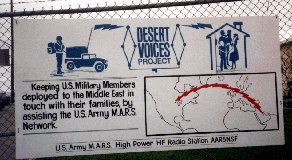 | During the buildup to the Gulf War the worry and stress felt by the families of U.S. service men and women began to grow quickly. Several of my friends and business acquaintances who had loved ones either on their way to or already in the Gulf began to talk about their fears for the safety of their loved ones. It soon became obvious that the stress was beginning to get to them. Especially, with a constant flow of up to the minute news flashes about attacks and military action. This fear was being compounded by the fact that mail was running so slow that weeks and months were passing without a word from their deployed loved ones and telephone service was not available to a majority of those deployed to that part of the world. As a communications professional I began to look around for a resource that could solve their communications problem. I found there were virtually no viable faster communications options open to them as military families. The only option that I did find was a Department of Defense program called MARS (Military Affiliate Radio System). The MARS staff and volunteers were doing their best to move an overwhelming amount of radio message traffic called MARSGRAMS. I was told "there is so much radio message traffic we are having to move it by airplane." The MARS program is also authorized to handle radio telephone calls from the troops in front line areas using their units tactical radio equipment, but it gone through budget cuts and had been downsized to the point where it only had one radio station in the U.S. that could reliably maintain communications over such a great distance 7000 miles. I was introduced to Yvonne Minor the co-founder of a military family support group called SOCM (Support Our Courageous Military). Yvonne stressed to me the importance and dire need for some sort of communications link between those in the Gulf and their families back here at home that would not deprive them of the little financial resources that many families had. She also expressed to me that many of these families were under tremendous stress and needed help now. As I owned a communications system design. consulting and contracting company, I told her that I would give it some thought. After a week of going over option after option, a workable solution began to form. On October 30th of 1990 I called Yvonne and told her that I thought I could build the communications bridge needed by the families, but it would be very large undertaking, expensive and that I could not do it alone. I also asked her if she felt there would be anyone out there willing to help me build this communications bridge. She assured me that she was sure that if I made the effort to build this dream, and let people know, people would come forward to help. I then called the MARS contact I had made on the East coast back and asked him, if I were to build a communications system capable of reaching front line locations in the Gulf, make it available to them and the military families without charge and operate it until they put more of their own stations on line, would it help and would they use it. The answer was a resounding YES! On October 31st, I talked again to Yvonne and then told her I would commit myself and do my best to move this dream into a reality, it would be called "The Desert Voices Project". I started by talking to companies and found many willing to help by leasing or loaning the equipment, land and materials I would need on a zero dollar basis for use in the project, if my company, NW Antenna & Communications, would accept financial responsibility and guarantee its return by the first week in May at the latest, sooner if the project was concluded prior to that date. I then contacted the media and informed them of my plans to build a communications center that would work as a temporary communications bridge between those serving in the Gulf and their families here at home. I also asked for volunteers to help me build this dream. The phone began to ring almost at once. By the time 2 weeks had passed over 100 people had called wishing to help. The amount of work was limited to office work until we had secured the land that we needed to act as the communications center. Work proceeded on locating this land with all possible speed and on November 9th an old 26 acre Nike Missile Base was found in a rural location that was radio quiet and large enough to hold the two massive antenna arrays that would be the key to the projects success. That same day, the government entity that owned it was located, a walk through of the buildings and property was conducted and a lease request was made. They were willing to help but it had to go in front of their legal department, chain of command and a lease would have to be drawn up and signed, this would take at lease 8 weeks so they would get started on it right away. This would allow us to gain access to the base around January 4 if all went well. But this was not to be as it seemed their chain of command understood what we were up to and the importance of it, plus they wanted to do all they could do to help. On November 19th , only 10 days later, we gathered at the front gate of the old Nike Base. Present were our volunteers, the representative from the U.S. Department of Interior, the media and myself. The keys to the base were turned over to me and the work began. I then made a plea through the media for volunteer radio operators from the Amateur Radio Community. The building selected for the projects communications center had been unused for about 20 years, the paint was falling off, windows and doors were warped and would not open or close. The heating system had not been drained and through the past winters the pipes had frozen and burst. Underground heating fuel tanks had not been drained and the fuel had jelled and was contaminated. The place was a mess, but it was easy to see both the potential and the work that would be needed to bring it back into operation. |
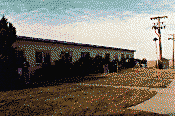 | Every day volunteers reported to the base to receive their work assignments for the day. It was not unusual to see 50 to 100 volunteers hard at work, bring the base back to life. The yard was cleared of brush and debris, then mowed. Hedges were trimmed. The building we had selected was given a thorough cleaning, a new coat of paint inside and out, and the windows and doors were either repaired or replaced. |
| Then the Electrical contractors arrived and rewired the building to accommodate the extra power needed by our transmitters. The Heating contractor arrived with their crew and went through the entire heating system fixing what they could and replacing what could not be repaired. The Heating Fuel supplier showed up with a new fuel tank and fuel, and the heat was turned on for the first time in about 20 years. |
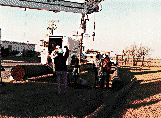 |  | By December 6th, work on the grounds and building had almost been completed, but more important was the fact that our main antenna array was ready for testing. In just 18 days amongst all that was going on we had managed to build one of the most powerful long range HF radio antenna arrays on the continent of North America. |
| This array was capable of focusing all of our radio energy into a very tight very powerful beam which would bounce between the uppermost surface of the earths atmosphere, then down bouncing off of the earths surface then back up repeating this action, growing wider with each bounce until its 4th return to earth where it literally was coming down on the opposite side of the earth covering the entire Gulf War area and thus all U.S. military positions front lines and rear. | 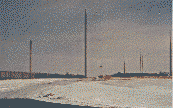 |
| On December 7th, with the help of over 100 volunteer radio operators from the Amateur Radio community, U.S. Army Reserve and Minnesota National Guard, the station began operating 24 hours a day 7 days a week, testing the alignment and calibrating our new very large antenna array. Installation of the rest of the communications equipment continued as it arrived at the base from around the country. December 13th, testing was successfully concluded. The military station license was received and the radios at the center were switched over to Department of Defense frequencies and the first contact with a military station in Saudi Arabia was made at about 2:00 that afternoon. The station remained in operation until May 1st, helping thousands of families by handling thousands of messages and radio phone calls from our troops in the Gulf to their families here at home. Messages were handled for families in all 50 States, Puerto Rico and 4 Provinces of Canada. |
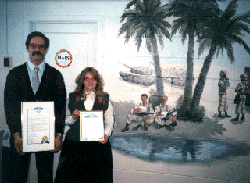 | It was a good feeling to be able to help so many families, the tears of happiness, the cries of joy and excitement at the arrival of a new son and daughter, the wedding proposals and oh so much more, but none of this would have ever been possible without the help of more then 300 volunteers and 45 companies who cared enough to came forward and help build the dream. To recognize a problem, to dream of making a change, to help others, is not enough if you can't find those that are willing to join the team and help make your dream into a reality.
|
| I would like to present to you a partial list of those companies that came forward to help. Not only to give them the recognition they deserve, but to give you some insight into the complexity of building this first military family support mission. I am very grateful to these companies and the many volunteers that had the faith in me and my vision to come forward and help make it such an overwhelming success. Advanced Electronic Applications of WA
Armor Security Inc. of MN
Bertelson Office Products of MN
Boise Cascade Corporation of MN
Burghardt Amateur Center of SD
Centel Telephone Co. (Frontier Tele.) of MN
Coordinated Business Systems of MN
Dakota Electric of MN
Delmar Schwanz Land Surveyors Inc. of MN
General Mills of MN
Heinrich Envelope of MN
Honeywell Inc., Military Aviation Gp. of MN
IBM and Computer Land of MN
Kenwood USA of CA
Knox Lumber Company of MN
Lakeville Motor Express of MN
Master Electric of MN | McDonald Graphics of MN
Mirage/KLM of CA
Northern States Power Co. of MN
Oliver D. Billings Engineering of MN
Pitney Bowes of MN
Plekkenpol Builders of MN
Rollins Oil Co. of MN
Rouse Mechanical of MN
Ruvelson, Kauter & Schmidt Ltd. MN
St. Paul Tower Company of MN
St. Paul Companies of MN
Studio One Inc. of MN
Technical Material Corp. of NY
Telex Hy-Gain of NE
U.S. Department of the Interior
W.A. Lang Ins. Co. of MN
Wagenaar Homes of Minnesota |
Respectfully,
Mr. Edward Addy, Founder & Director
The Desert Voices Project, (DVP)
The North American Center For Emergency Communications, (NACEC)
|
|